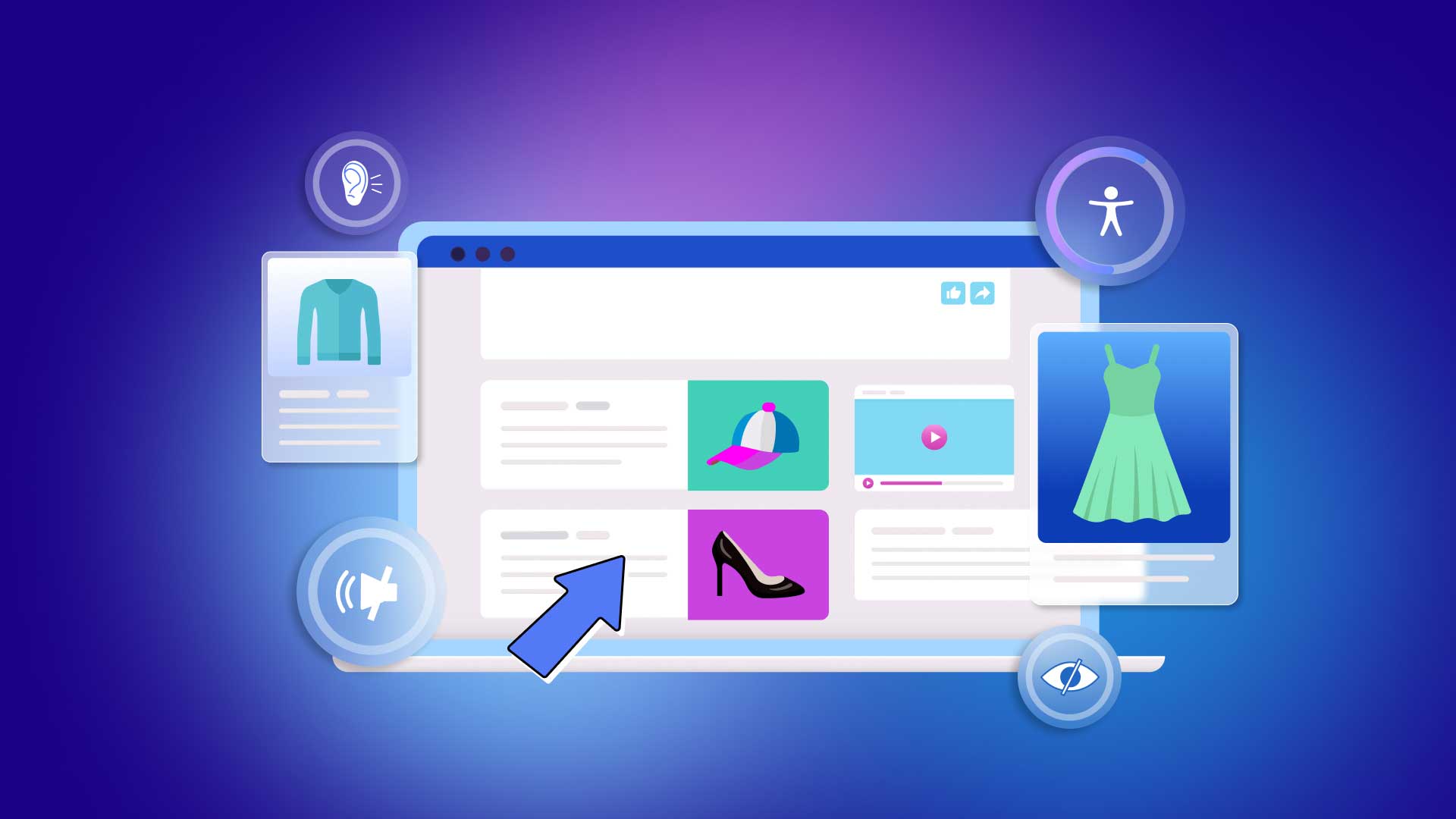Web couture: designing accessible clothing websites

Fashion, whether showcased on the runway, in our retail stores, or on our clothing websites, serves as a creative outlet for self-expression. It enables us to express our individuality, innovation and sense of style. Yet, for far too long, the fashion industry has overlooked a significant portion of society: individuals with disabilities. The good news is that a paradigm shift is underway, as accessible fashion emerges as a movement breaking down barriers and promoting inclusivity for all.
What is accessible fashion?
Accessible fashion goes beyond mere aesthetics, prioritizing functionality, comfort, and adaptive features. By embracing inclusive design principles, accessible fashion ensures that individuals with disabilities can express themselves confidently while enjoying independence and equal participation in everyday life.
Accessible fashion also plays a vital role in challenging societal perceptions and dismantling stereotypes surrounding disability. By showcasing the fashion choices and unique styles of individuals with disabilities, it helps redefine societal standards of beauty, breaking free from narrow definitions and embracing the diverse spectrum of what it is to be human.
Moreover, accessible fashion is not only about the garments we wear but extends to the entire fashion ecosystem, including clothing websites. By making fashion websites accessible, individuals with disabilities gain equal access to information, online shopping experiences, and opportunities for self-expression. It is a gateway to a more inclusive and equitable online world, where fashion is truly for everyone.
The challenge for online clothing websites
It isn’t always easy to find fashionable and functional clothing. One of the primary challenges is the limited availability of clothing options designed with accessibility in mind. Traditional fashion has often overlooked the specific requirements of individuals with disabilities, leaving a void in the market for clothing that caters to their needs. This lack of representation results in a limited selection of stylish, well-fitting, and functional garments that accommodate diverse body types, mobility aids, and sensory sensitivities.
Another challenge is the lack of awareness and understanding within the fashion industry. Many designers and brands are unaware of the specific needs and desires of individuals with disabilities, leading to a lack of inclusive design considerations. Without this awareness, fashion offerings often fail to meet the practical requirements and aesthetic preferences of people with diverse needs.
Accessibility also extends beyond physical aspects to the digital arena. Individuals with disabilities often encounter barriers when browsing online clothing websites.
Websites for clothes provide a convenient and expansive platform for shoppers to explore and purchase a wide variety of fashionable apparel, catering to different styles, sizes, and preferences. However, inaccessible websites, lack of alternative text for images, complex navigation, and insufficient product descriptions can impede their ability to browse, select, and make informed choices. This creates a digital divide, denying equal access and opportunities for individuals with disabilities to enjoy online clothes shopping sites or participate in the fashion e-commerce space.
The challenges that inaccessible clothing websites pose to some individuals serve as catalysts for change. They ignite a call to action for the fashion industry and even the most popular online clothing stores to prioritize inclusivity and accessibility. By addressing these obstacles head-on, we can foster a fashion landscape that celebrates diversity, empowers individuals of all abilities, and enables everyone to enjoy the freedom of self-expression through creativity, style and functional clothing.
Websites for clothes: where functionality meets fashion
Adaptive clothing is reshaping the fashion industry by seamlessly merging functionality and style. Gone are the days when accessible apparel meant sacrificing aesthetics for practicality. Today, a remarkable array of innovative adaptive fashion brands and designs exists, offering individuals with diverse needs the freedom to express their unique style while ensuring clothing meets their specific requirements.
Tommy Adaptive, a leading U.S. online clothing store, sets the standard for inclusive design, focusing on ease of movement and making dressing a more effortless experience. While not as widely known as some popular clothing websites, Unhidden, stands out by offering universal fashion designs that cater to diverse body types, promoting inclusivity and embracing the beauty of individuality.
Let’s look at some of the different types of adaptive clothing that embody this powerful combination:
1. Magnetic Closures and Easy Fastenings
Magnetic closures have emerged as a game-changer, providing a hassle-free alternative to traditional buttons or zippers. They are particularly beneficial for individuals with limited dexterity, arthritis, or conditions that affect fine motor skills.
Adaptive clothing also incorporates other easy fastening mechanisms like Velcro, snap buttons, or hooks that make dressing and undressing effortless, enhancing independence and reducing frustration.
2. Adjustable Features and Customization
Adaptive designs often incorporate adjustable elements to accommodate various body shapes and fluctuations. For instance, waistbands with elastic or drawstrings allow for a personalized fit, ensuring comfort and flexibility.
Customization options, such as adjustable hems, sleeve lengths, or removable components, empower individuals to modify garments according to their specific needs and preferences.
3. Sensory-Friendly Fabrics and Tagless Designs
Sensory sensitivities can make certain fabrics uncomfortable or irritating for individuals with conditions like autism or sensory processing disorders. Adaptive clothing addresses this by incorporating sensory-friendly fabrics, such as soft, hypoallergenic materials that provide comfort without compromising style.
Tagless designs have also gained popularity, eliminating scratchy tags that can cause discomfort. Instead, important garment information is printed directly on the fabric or placed on removable tags.
4. Open-Back and Side-Opening Garments
Open-back and side-opening garments are designed for individuals with limited mobility or those who require assistance with dressing. These adaptive features enable easier access to dress or undress, often utilizing discreet closures or strategically placed openings without compromising style or aesthetics.
5. Wheelchair-Friendly Clothing
Adaptive clothing for wheelchair users incorporates thoughtful design elements, such as reinforced seat areas, extended back hems, or shorter front hemlines. These adaptations provide optimal comfort, prevent fabric bunching, and maintain a polished appearance while seated.
6. Accessible Footwear
Adaptive footwear designs address a range of needs, from easy slip-on shoes with elastic or adjustable closures for individuals with limited dexterity to shoes with wider toe boxes to accommodate foot deformities or orthotic inserts.
Innovative designs may also include hidden pockets for medical devices or seamless linings to reduce friction and pressure points.
Adaptive fashion goes beyond being just a passing trend; it has become an essential requirement that every brand and these examples represent just a fraction of the adaptive fashion options available today. By embracing functional features while upholding style and fashion-forward design, adaptive clothing empowers individuals with disabilities to express themselves authentically, enhancing their confidence, comfort, and independence.
Style unlocked: building an inclusive fashion website
The world of fashion and clothing is witnessing exciting innovations at the intersection of accessibility and style, but, while progress is being made in improving fashion accessibility, are our ecommerce stores as accessible as our outfits? Let’s explore the world of website accessibility and how we can build shopping websites for clothes that promote equal and accessible experiences for our audiences:
1. Picture-Perfect Descriptions
We all live for stunning visuals, right? But let’s not forget that some of our fellow fashionistas might not see those aesthetically pleasing images. That’s where alternative text comes in! By adding vibrant and descriptive captions to our fashion website images, we ensure that everyone, regardless of visual ability, can envision the stunning outfits we have to offer.
2. Navigation
Just like we navigate the trendiest boutiques with ease, our trendy clothing websites should be a breeze to explore. Think logical and organized menus, clear headings, and seamless page transitions. We want every fellow fashion-forward shopper to find their perfect pieces effortlessly, whether they’re scrolling on a laptop or swiping through a mobile screen.
3. Bold and Beautiful
We adore playing with colors and fonts to create eye-catching looks so let’s extend that creativity to our clothing websites too. By using bold colors and high contrast combinations, we make sure that every word and detail on the screen pops, allowing everyone to read our content with ease. And don’t forget to give our fashion-forward shoppers the option to adjust font sizes because we all have different preferences!
4. Keyboard Couture
Just like a trendy accessory, keyboard accessibility is a must-have for our websites. Some of our fashion-forward friends may rely on keyboards instead of a mouse or touchpad. Let’s make sure that every button, link, and interactive element on our websites is fully operable with just a few keystrokes.
5. Lights, Camera, Captions
We’re not just about static images, are we? Our fashion shows and videos bring our creations to life! Let’s make sure that everyone can join the front row. By adding captions or providing transcripts for our videos, people who are deaf or hard-of-hearing will never miss a beat.
6. Details, Darling
We know that fashion is all about the details, and our product descriptions are no exception. Let’s go beyond the basics and give our shoppers all the juicy details they crave. Size, material, fit, care instructions—let’s serve up all the information people need to make fabulous fashion decisions tailored to their tastes and requirements.
Let’s take the accessibility of our clothing websites to the next level and make them as stylish and inclusive as our outfits – one trendy clothing website at a time.
UserWay: Accessibility First & Fashion Forward
At UserWay, web accessibility never goes out of style. In a world where equal access and inclusivity are no longer mutually exclusive, we are paving the way to a digital space where everyone can easily explore, engage, and embrace their fashion style online. Whether it’s our market-leading Accessibility Solution that can remediate your clothing websites’ accessibility issues or our Web Accessibility Audits designed to bring your sites, apps, designs, and digital assets into compliance with accessibility standards and law, UserWay can help you showcase your clothing in true accessible style that leaves no one behind.
FAQS
What is meant by ‘web couture’?
Web couture is a term that combines the concepts of web design and fashion (or haute couture). It refers to the practice of creating highly customized, luxurious, and visually stunning websites that are tailored to the specific needs and preferences of individual clients or brands.
What does web accessibility mean for the fashion industry?
Web accessibility in the fashion industry refers to the practice of designing and developing fashion websites and online platforms in a way that makes them accessible and usable for people with disabilities.
How can I make my clothing website inclusive?
To make your clothing website inclusive, ensure it has clear and descriptive alt text for images, provides resizable text for those with visual impairments, uses high contrast for readability, and implements keyboard navigation for users with mobility impairments. Consider providing closed captioning for videos and ensuring compatibility with assistive technologies.




Share